Summary
Corn is a warm-season crop. Germination and emergence are optimal when soil temperatures are approximately 85 to 90 F. Cool conditions during planting impose significant stress on corn emergence and seedling health.
Corn seed is particularly susceptible to cold stress during imbibition. Warmer, moist conditions for the first 24-48 hours after planting can mitigate much of the cold stress.
In lighter-textured soils, spring nighttime temperatures can drop significantly below 50 F, even after warm days, inflicting extra stress on corn emergence.
High amounts of residue can slow soil warming and the accumulation of soil GDUs needed for corn emergence.
DuPont Pioneer offers product ratings such as stress emergence (SE) and high-residue suitability (HRS) scores to help growers manage for productive stands under stress or high-residue conditions.
Pioneer also offers industry-leading seed treatments that help protect seed from damage caused by multiple early-season pests.
Introduction
Successful corn emergence is a combination of 3 key factors – environment, genetics and seed quality (Figure 1).
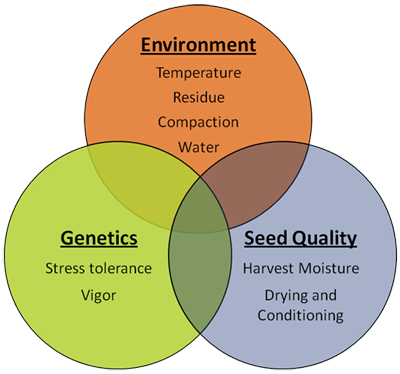
Figure 1. Some critical environmental, genetic and seed quality factors that affect stand establishment.
Hybrid genetics provide the basis for tolerance to cold stress. High seed quality helps ensure that the seed will perform up to its genetic ability. Pioneer concentrates on selecting the best genetics for consistent performance across a wide range of environments and producing high quality seed. However, even with the best genetics and highest seed quality, environmental factors can still dictate stand establishment. Pioneer provides research-based advice that can help growers make informed decisions and better manage their field operations to maximize stands.
Soil temperatures at planting are a key environmental component of stand establishment. It is generally recommended that growers plant when soil temperatures are at or above 50 F. However, soil conditions after planting are also critical (Figure 2).
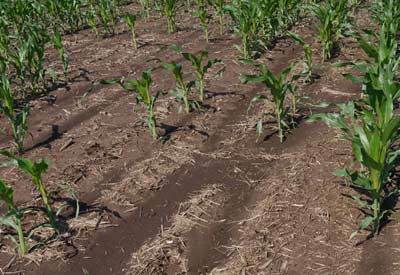
Figure 2. Low soil temperatures after planting greatly reduced stands at a stress emergence site near Eau Claire, WI, in 2011.
This Crop Insights discusses how the level and timing of cold stress affects seed germination and emergence and how growers can mitigate these stresses when planting in challenging environments.
Optimal Temperature for Early Corn Growth
Corn is a warm-season crop and does best under warm conditions. In North America, early-season planting typically puts stress on the corn seedlings. To help understand optimal corn growth, 3 hybrids of early, mid and late maturities were germinated in temperatures ranging from 59 to 95 F (15 to 35 C). Growth rates of both roots and shoots were measured. All 3 hybrids were averaged to determine the optimal temperature for corn growth. Both shoots and roots exhibited the fastest growth rate at 86 F (30 C) and continued to grow rapidly at 95 F (35 C), suggesting optimal seedling germination and emergence occurs at much higher soil temperatures than are common in most corn producing areas (Figure 3). Growers can expect much slower emergence and growth at the cool soil temperatures that are typical during U.S. and Canada corn planting.

Figure 3. Average early root and shoot growth rates for 3 hybrids under 4 soil temperatures ranging from 59 to 95 F.
Genetic Differentiation for Emergence in Cold Soils
Soil temperatures after planting are often a good indication of stress level, and stands may be reduced when average soil temperatures are below 50 F (Figure 4). DuPont Pioneer provides stress emergence (SE) scores for all North America commercial hybrids to help growers manage early-season risk. Choosing hybrids with higher SE scores can help reduce genetic vulnerability to stand loss due to cold soil temperatures.
In 2009, a wide range of stress emergence conditions and soil temperatures were seen in the Pioneer stress emergence field plots. To demonstrate how stress emergence scores relate to stand establishment in the field, hybrids were grouped by "low SE" - those with an SE rating of 3 or 4, and "high SE" - those with an SE rating of 6 or 7.
Seventy low SE hybrids and 146 high SE hybrids were represented in the trials. Early stand counts for all hybrids within each group were averaged at each location. As stress level increased, both the low SE and high SE hybrids experienced stand loss. However, the hybrids with a SE score of 6 or 7 were able to maintain higher stands as compared to those with a low SE score (Figure 4).
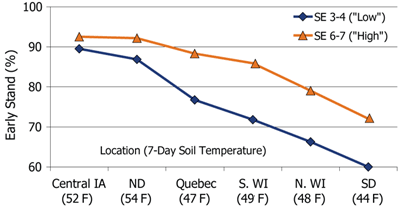
Figure 4. Average stand establishment for high and low SE score hybrids in 6 stress emergence locations in 2009. Locations are sorted from least stressful (left) to most stressful (right) based on average early stand.
Planting date remains a critical management factor to help growers minimize the risks associated with suboptimal conditions for germination. Planting into cold, wet soils inflicts stress on corn seed emergence, as does planting just ahead of a cold spell. In some years, corn may be planted prior to a cold rain or snow, resulting in the seed sitting in cold, saturated soils (Figure 5).
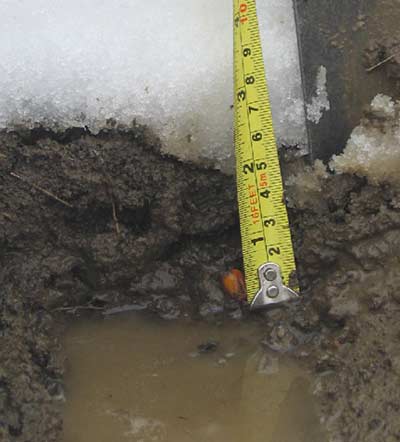
Figure 5. Snowfall soon after planting imposes a very high level of stress on corn emergence due to seed imbibing chilled water or prolonged exposure to cold, saturated soils.
Timing of Cold Stress Impacts Germination
To help understand the importance of the timing of cold stress, 2 hybrids with SE scores of 4 (below average) and 7 (above average) were allowed to germinate in rolled towels for 0, 24, or 48 hours at 77 F (25 C). The hybrids were then subjected to a stress of melting ice for 3 days and allowed to recover for 4 days at 77 F (25 C). Hybrids were evaluated for the number of normal seedlings reported as percent germination (Figure 6).
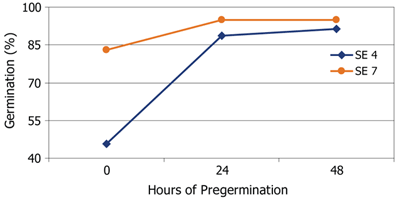
Figure 6. Germination of 2 hybrids with stress emergence scores of 4 (below average) and 7 (above average) following imbibitional chilling induced by melting ice. Ice was applied immediately after planting (0 hours) or after 24 hours or 48 hours of pregermination in warm conditions.
Both hybrids showed significant stand loss when the cold stress was imposed immediately (0 hours). However, the hybrid with a higher SE score had a higher percent germination than the hybrid with a low SE score. Germination rates for both hybrids were greatly improved if allowed to uptake water and germinate at warmer temperatures for at least 24 hours before the ice was added.
Data suggests that planting just before a stress event such as a cold rain or snow can cause significant stand loss. The chances of establishing a good stand are greatly improved if hybrids are allowed to germinate at least 1 day in warmer, moist conditions before a cold-stress event. Also, choosing a hybrid with a higher stress emergence score can help moderate stand losses due to cold stress.
One reason why temperature during imbibition is critical to corn emergence is the fact that seed imbibes most of the water needed for germination very rapidly. To illustrate the rapid timing of water uptake, seed was submerged in 50 F water for 3 hours and weighed at intervals of 30, 60, 120 and 180 minutes to determine water uptake (Figure 7).
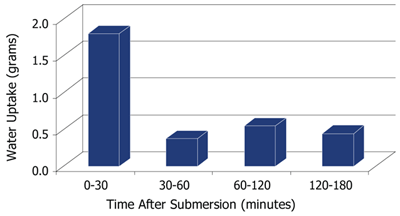
Figure 7. Amount of water uptake by corn seed during the first 3 hours after submersion in 50 F water.
The data show that seed imbibes the most water within the first 30 minutes after exposure to saturated conditions. If this early imbibition occurs at cold temperatures, it could kill the seed or result in abnormal seedlings. Growers should not only consider soil temperature at planting, but also the expected temperature when seed begins rapidly soaking up water. Seed planted in warmer, dry soils can still be injured if the dry period is followed by a cold, wet event.
Soil Temperature Fluctuations and Emergence
Growers are often able to plant fields with sandier soils earlier in the spring because they dry out faster than heavier soils. However, reduced stands after early planting have often been noted in sandier soils. Sandy soils are more porous and have lower water holding capacity than heavier soils. As such, they tend to experience wider temperature fluctuations, especially on clear nights with cold air temperatures.
In 2009, soil temperatures were recorded at a 2-inch depth in a stress emergence location with sandy soils near Eau Claire, WI. Daytime soil temperatures reached acceptable levels for corn development (over 50 F) for the first week after planting. However, the early morning soil temperatures dipped to as low as 35 F, and on some days the soil temperature difference between 6 AM and 6 PM was close to 20 F (Figure 8). An average 25% stand loss was observed at this location, suggesting that day-night temperature fluctuation after planting can pose an added stress on germinating corn. Growers should be aware of expected nighttime temperatures when choosing a planting date.
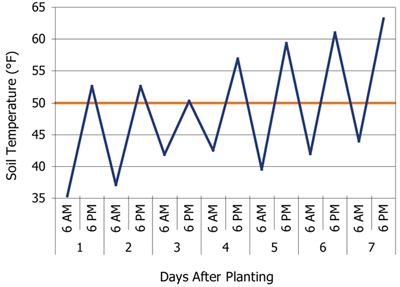
Figure 8. Soils temperatures at 6 AM and 6 PM for 7 days after planting in a stress emergence field location near Eau Claire, WI, in 2009.
Impact of Crop Residue on Soil Temperature
Another factor to consider when choosing planting date is the amount of residue in the field. High amounts of residue can present management challenges. Residue tends to hold excess water and significantly lower soil temperature in the spring, depriving seed of critical heat units needed for rapid emergence. These conditions can also promote seedling disease, particularly in fields that are not well drained or have a history of seedling blights.
In 2011, soil temperature data loggers were placed in a field near Perry, IA to assess early soil temperatures in a strip-till field. One data logger was placed in the tilled planting strip (low residue) and 1 was placed in between the rows under high residue. Soil GDUs were calculated from the data logger temperatures to approximate how long emergence would take under low and high residue conditions. In general, approximately 125 soil GDUs are needed after planting for corn emergence (Nielsen, 1999). From April 1 to April 30, soils under low residue were able to accumulate 99 soil GDUs. During the same timeframe, neighboring soils under heavy residue accumulated only 28 soil GDUs.
Even in late May after the crop had emerged, an 11-degree midday temperature difference was noted in the same field between soil under low residue and soil under heavy residue using a soil thermometer (Figure 9). Using a row cleaner to clear residue off the row in high residue fields allows for warmer daytime soil temperatures and faster GDU accumulation.
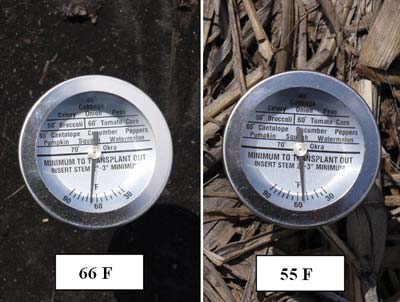
Figure 9. An 11-degree temperature difference was observed midday in late May 2011 in a central IA field between soil under no residue (left picture) and soil under heavy residue (right picture).
Tips to Help Mitigate Early-Season Stress Effects on Emergence
Delayed emergence due to cold, wet conditions lengthens the duration during which seed and seedlings are most vulnerable to early-season insects and diseases. Seed treatments can help protect stands from both disease and insect pests. The PPST 250 seed treatment, which is standard on all Pioneer® brand corn hybrids in the U.S., includes fungicide (multiple modes of action), insecticide and biological components. In areas with high nematode or insect pressure (such as cut worm or wireworm), growers can choose the added protection of Poncho® 1250 + VOTiVO® seed treatment. For more information on seed treatments offered by DuPont Pioneer, contact your local sales rep or visit the soybean seed treatment and corn seed treatmentsections on pioneer.com.
Planting date is one of the most important factors in stand establishment. The likelihood of reduced stands is greatest when planting in to cold, wet soils or directly before cold, wet weather is expected. To help mitigate risk, consider the following tips:
If a cold spell is expected around planting time, it is advisable to stop planting 1 or 2 days in advance. Allow seed to begin hydration in warmer soils in order to minimize damage due to cold imbibition.
In sandy fields, be aware that low nighttime temperatures can dip soil temperatures below advisable planting levels. Large temperature swings in lighter soils can also hurt emergence.
If planting in fields with high amounts of residue, consider strip-tillage or use a row cleaner to allow soils to warm up faster.
Selecting hybrids with higher stress emergence scores and the right seed treatment can help reduce the risks associated with planting in cold-stress conditions.
Additional Resources
DuPont Pioneer. 2012. Pioneer premium seed treatment – Corn.
Nielsen, R.L. 1999. Soil Temperature, Corn Emergence and Stand Problems. Chat ‘n Chew Café.
Saab, I. 2009. Lessons from early planted corn emergence trials. Crop Insights Vol. 19, No. 7.
Saab, I. 2012. Stress emergence in corn. Crop Insights Vol. 22, No. 8.
Stoll, M. and I. Saab. 2010. Maximizing corn emergence and uniformity in high-residue fields.Crop Insights Vol. 20, No. 10.
1Maria Stoll, Senior Research Associate, DuPont Pioneer, Johnston, IA.
2Imad Saab, Research Scientist, DuPont Pioneer, Johnston, IA.
back to top
Pioneer Hi-Bred | Crop Insights: Soil Temperature and Corn Emergence
Another factor to consider when choosing planting date is the amount of residue in the field. High amounts of residue can present management challenges. Residue tends to hold excess water and significantly lower soil temperature in the spring, depriving seed of critical heat units needed for rapid emergence. These conditions can also promote seedling disease, particularly in fields that are not well drained or have a history of seedling blights.
In 2011, soil temperature data loggers were placed in a field near Perry, IA to assess early soil temperatures in a strip-till field. One data logger was placed in the tilled planting strip (low residue) and 1 was placed in between the rows under high residue. Soil GDUs were calculated from the data logger temperatures to approximate how long emergence would take under low and high residue conditions. In general, approximately 125 soil GDUs are needed after planting for corn emergence (Nielsen, 1999). From April 1 to April 30, soils under low residue were able to accumulate 99 soil GDUs. During the same timeframe, neighboring soils under heavy residue accumulated only 28 soil GDUs.
Even in late May after the crop had emerged, an 11-degree midday temperature difference was noted in the same field between soil under low residue and soil under heavy residue using a soil thermometer (Figure 9). Using a row cleaner to clear residue off the row in high residue fields allows for warmer daytime soil temperatures and faster GDU accumulation.

Figure 9. An 11-degree temperature difference was observed midday in late May 2011 in a central IA field between soil under no residue (left picture) and soil under heavy residue (right picture).
Tips to Help Mitigate Early-Season Stress Effects on Emergence
Delayed emergence due to cold, wet conditions lengthens the duration during which seed and seedlings are most vulnerable to early-season insects and diseases. Seed treatments can help protect stands from both disease and insect pests. The PPST 250 seed treatment, which is standard on all Pioneer® brand corn hybrids in the U.S., includes fungicide (multiple modes of action), insecticide and biological components. In areas with high nematode or insect pressure (such as cut worm or wireworm), growers can choose the added protection of Poncho® 1250 + VOTiVO® seed treatment. For more information on seed treatments offered by DuPont Pioneer, contact your local sales rep or visit the soybean seed treatment and corn seed treatmentsections on pioneer.com.
Planting date is one of the most important factors in stand establishment. The likelihood of reduced stands is greatest when planting in to cold, wet soils or directly before cold, wet weather is expected. To help mitigate risk, consider the following tips:
If a cold spell is expected around planting time, it is advisable to stop planting 1 or 2 days in advance. Allow seed to begin hydration in warmer soils in order to minimize damage due to cold imbibition.
In sandy fields, be aware that low nighttime temperatures can dip soil temperatures below advisable planting levels. Large temperature swings in lighter soils can also hurt emergence.
If planting in fields with high amounts of residue, consider strip-tillage or use a row cleaner to allow soils to warm up faster.
Selecting hybrids with higher stress emergence scores and the right seed treatment can help reduce the risks associated with planting in cold-stress conditions.
Additional Resources
DuPont Pioneer. 2012. Pioneer premium seed treatment – Corn.
Nielsen, R.L. 1999. Soil Temperature, Corn Emergence and Stand Problems. Chat ‘n Chew Café.
Saab, I. 2009. Lessons from early planted corn emergence trials. Crop Insights Vol. 19, No. 7.
Saab, I. 2012. Stress emergence in corn. Crop Insights Vol. 22, No. 8.
Stoll, M. and I. Saab. 2010. Maximizing corn emergence and uniformity in high-residue fields.Crop Insights Vol. 20, No. 10.
1Maria Stoll, Senior Research Associate, DuPont Pioneer, Johnston, IA.
2Imad Saab, Research Scientist, DuPont Pioneer, Johnston, IA.
back to top
Pioneer Hi-Bred | Crop Insights: Soil Temperature and Corn Emergence




No comments:
Post a Comment